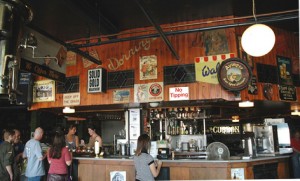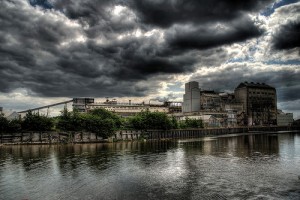
Quiggins Brooke Cafe, by Indigo Goat via Flickr
Nina Simon, a museum blogger I greatly admire and enjoy reading, recently posted on the topic of ‘exclusive’ places, and the odd way in which people find them more welcoming than more public spaces. She was referring to museums, which can be both public spaces and yet sometimes seem exclusive (to ‘museum-y people’), but everywhere in the landscape can have a sense of exclusivity, to a greater or lesser extent. There’ll be parts of Liverpool you love going to, and which you like because you know ‘your’ people will be there: those with similar interests, from similar backgrounds, of similar age or profession, even people dressed similarly. There’ll be other places which you’d never set foot in: either you simply never go to that part of town, or you avoid drinking in that pub, going into those shops/restaurants. These places make you feel awkward, out of place, nervous, or it may be that they just don’t ‘do’ what you like. Then there are places which change from one type to another over your lifetime: perhaps you grow into them (that pub again) or out of them (playground, playing fields, the street where you grew up).
You may go with friends, or alone, but they are all places which reinforce your feeling of who you are, and who you aren’t. You can share these special places with the right friend; you get that glow from sharing an exclusive place and introducing someone new to something cool.
When I was but a young geek, my friends and I would go to Palace on Slater Street, for all our collectible card game needs! The place was full of other weird and wonderful shops: antiques, piercings, records, books, junk… Quiggins, in its School Lane incarnation, was similar: I loved the cafe on the top floor, and exploring the darkest, strangest recesses of the other shops. Both those places I knew my parents, and my more ‘mainstream’ classmates, would never go. They were my places, and my friends’ places.
Then there is the garden behind Blue Coat Chambers. I was first taken there by a Geography teacher while on a field trip (with 29 other lads, I’ll have you know). It was a little-known backstreet oasis, with a couple of benches, plants and trees. Neglected, maybe, but not overgrown, it seemed like a bit of a secret getaway. This year I went back, possibly for the first time in (yikes) ten years, with my fiancée. It’s had a complete makeover, along with the Chambers themselves, but still maintained an air of quiet solitude, somewhere to escape the massive and modern Liverpool One just over the wall. I felt that sense of showing someone that place for the first time, a place which had been shared with me and a handful of (slightly rowdy) others years before.
There are countless other places which are ‘mine’: parks at Croxteth, Springfield, Sefton, Calderstones (and the corners within them), where I spent parts of my childhood, and which I still visit. If I choose to share these places, at the same time I want to keep them secret, and not to share them with too many people lest they lose that exclusiveness, that specialness.
Which are your ‘exclusive places‘? Are they, like in Nina’s examples, museums? Exhibits? A corner of a gallery? Or one of Liverpool’s parks, or independent shops? Are they big places, or small? Do you share them? Where do you feel you are most you, and how does the location of that place in the landscape affect this? Is it near home? Far from home? In a side street? Right in the limelight with the other trendy people?
Will you share it with the readers of some archaeology blog? 😉






